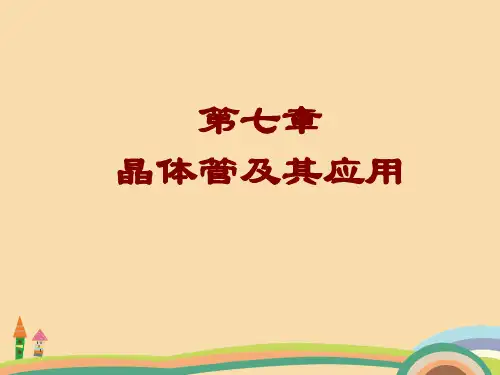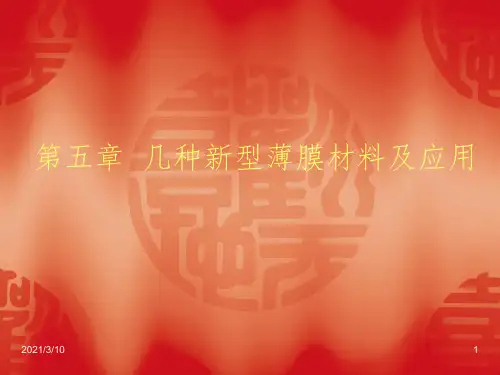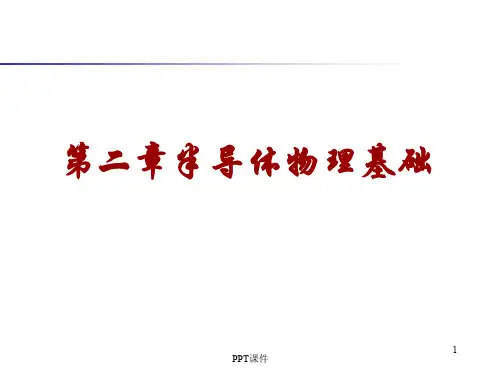有机薄膜晶体管材料器件和应用(孟鸿,黄维著)思维导图
- 格式:xmin
- 大小:6.11 KB
- 文档页数:1

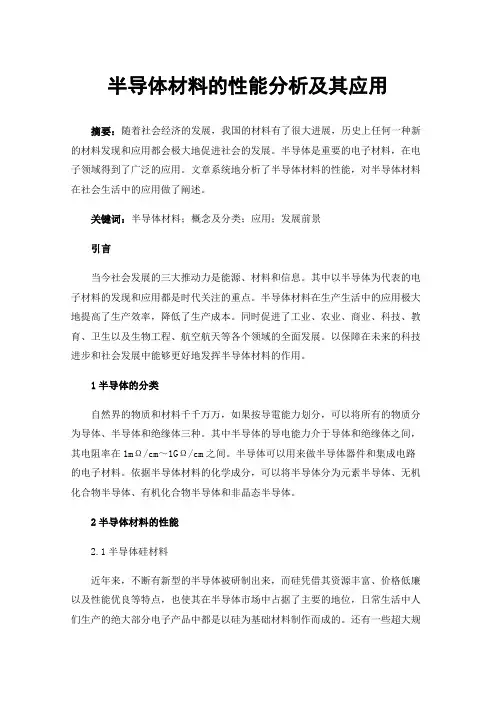
半导体材料的性能分析及其应用摘要:随着社会经济的发展,我国的材料有了很大进展,历史上任何一种新的材料发现和应用都会极大地促进社会的发展。
半导体是重要的电子材料,在电子领域得到了广泛的应用。
文章系统地分析了半导体材料的性能,对半导体材料在社会生活中的应用做了阐述。
关键词:半导体材料;概念及分类;应用;发展前景引言当今社会发展的三大推动力是能源、材料和信息。
其中以半导体为代表的电子材料的发现和应用都是时代关注的重点。
半导体材料在生产生活中的应用极大地提高了生产效率,降低了生产成本。
同时促进了工业、农业、商业、科技、教育、卫生以及生物工程、航空航天等各个领域的全面发展。
以保障在未来的科技进步和社会发展中能够更好地发挥半导体材料的作用。
1半导体的分类自然界的物质和材料千千万万,如果按导電能力划分,可以将所有的物质分为导体、半导体和绝缘体三种。
其中半导体的导电能力介于导体和绝缘体之间,其电阻率在1mΩ/cm~1GΩ/cm之间。
半导体可以用来做半导体器件和集成电路的电子材料。
依据半导体材料的化学成分,可以将半导体分为元素半导体、无机化合物半导体、有机化合物半导体和非晶态半导体。
2半导体材料的性能2.1半导体硅材料近年来,不断有新型的半导体被研制出来,而硅凭借其资源丰富、价格低廉以及性能优良等特点,也使其在半导体市场中占据了主要的地位,日常生活中人们生产的绝大部分电子产品中都是以硅为基础材料制作而成的。
还有一些超大规模集成电路、大规模集成电路和集成电路也都是通过硅材料或者是硅晶体的衍生材料制作而成的,由此可见,硅材料在集成电路的发展中有着推进的作用。
早在20世纪末硅材料就被研究和开发成为电子科学技术的主要材料,并且应用到了各个领域,其每年的需求量也都呈现急速增长的趋势。
依照现在世界各国所消耗的硅材料的数量来看,硅在未来极有可能成为电子通信领域以及计算机领域中的重要半导体材料。
如果在科技发展的过程中没有硅材料的支持,就不会使电子科技领域在短时间内得到迅速发展。
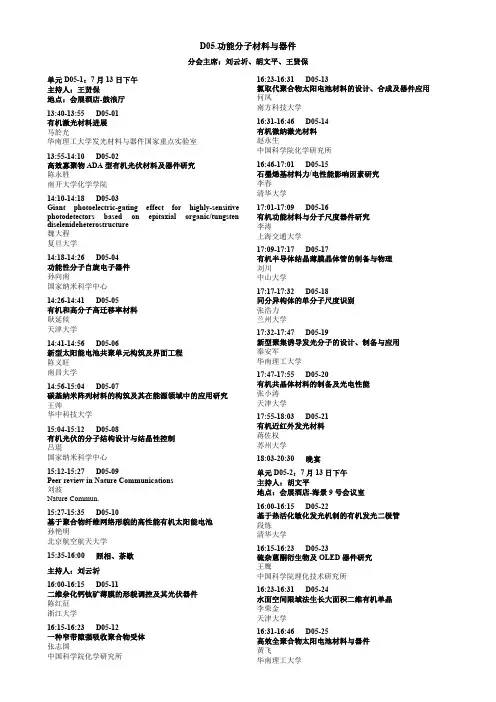


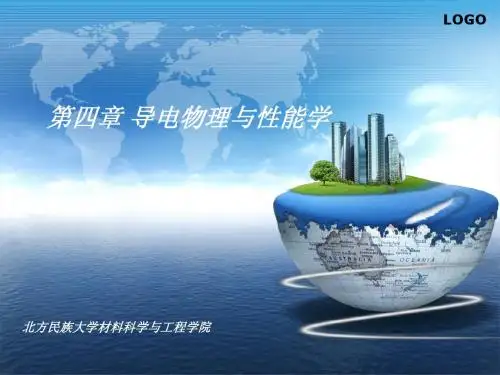
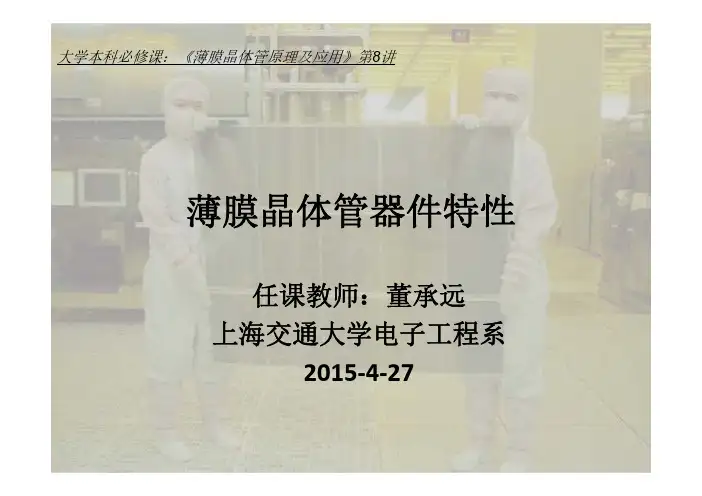
大学本科必修课:《薄膜晶体管原理及应用》第8讲薄膜晶体管器件特性任课教师:董承远上海交通大学电子工程系2015‐4‐27薄膜晶体管的操作特性及机理Review: Output Characteristics of NMOSpReview: Transfer Characteristics of NMOSa ce e t ode Depletion ModeEnhancement Mode Depletion ModeQualitative Comparison BetweenNMOS & TFTsI‐V Characteristics of TFTsCh t i ti f TFTTransfer Characteristics of a-Si: H TFTs Output Characteristics of an a-Si TFTgy gReview:Energy Band Diagram of a‐Si:HWeak BondsWeak BondsDeep StatesCovalent BondsOperation p .)I d (A mRegionAbove‐ThresholdIn the above-threshold region, the Fermi-level goes into the※In the above threshold region the Fermi level goes into the conduction band tail due to the high positive gate voltage (V GS>V T);※The conduction band tail and its associated parameters such as n ti and v ti determine the characteristics of the TFT in the above-d d t i th h t i ti f th TFT i th b threshold regime of operation.Sub RegionForward ‐threshold SiN Si HSiN E CGate a ‐SiNx a ‐Si:H a ‐SiNx E V E FSE FM qV a※In the forward subthreshold region the Fermi-level is in the middle of the band gap close to its intrinsic level Thus the middle of the band gap close to its intrinsic level. Thus, the density of trapped electrons at the a-Si:H / insulator interfaces and deep states of the a-Si:H gap is higher than interfaces and deep states of the a Si:H gap is higher than other charge components.Reverse Sub‐thresholdRegion※A high density of interface states is present at the back interface, which leads to a high density of intrinsic electrons at this interface. This electron channel (back channel) id f d ti b t th d i d provides a means for conduction between the drain and source electrodes in the reverse substhtrehold region.Poole‐Frenkel Emission Region※The holes are generated as a result of the Poole-Frenkel field-enhanced thermionic emission at the gate-drain overlap region. The leakage current results by virtue of conduction through the reverse-biased diode at the draind ti th h th bi d di d t th d i overlap region, which is enhanced by the electric field.Off‐Current in a‐Si TFTsQ:What factors may influence the Poole Frenkel Effect Q: What factors may influence the Poole-Frenkel Effect in a-Si TFTs?Review: DOS in ‐SipOperation of p‐Si TFTs-The carrier density increases as the gate voltage is increased.The carrier density increases as the gate voltage is increased-The grain boundary potential decreases as the gate voltage or drain voltage are increased.p() Operation of p‐Si TFTs (cont.)Operation of p‐Si TFTs (cont.)p-At low V g and V d(low field, I off is low and varies almost linearly with the V d. -At higher field, I varies almost exponentially with V and exhibits a g,off p y gdependency only on the channel width. This suggests that carriers are being emitted from the drain space charge region.Operation of p‐Si TFTs (cont.)(a)Thermionic Emission (TE)(b)Field Emission (FE)()(c)Thermionic FieldEmission (TFE, or Poole-Frenkel Emission)F k l E i i)Operation of p‐Si TFTs (cont.)Short ‐Si Chanel Effect in p TFTsChanel Effect in p TFTs(cont) Short ‐Si (cont.)Chanel Effect in p TFTs (cont )N T VariationShort ‐Si (cont.)Chanel Effect in p TFTs(cont) Short ‐Si (cont.)Chanel Effect of p(cont) Short ‐Si TFTs (cont.)Short ‐Si (cont.) Chanel Effect in p TFTs(cont)Short Chanel Effect in p‐Si TFTs (cont.) Drain-Induced Grain Barrier Lowering Effects (DIGBL) Effect薄膜晶体管操作特性的简单物理模型Spice Models of NMOS Review:Level 1:Level1:Level 3:Review: ExampleSolution:Level 3:Level 1:Conclusion: Obviously the drain current is significantly overestimated by Level 1 model.of TFTsModeling Directly modeling TFTs’ above threshold region with MOSFET Level 1of TFTs(cont)Modeling (cont.)•There exist two different points in the operational essence betweenTFTs and MOSFETs:‐TFTs operate at accumulation statel ipwhile MOFETs operate at inversion mode.‐TFTs possess much localized states inth i ti l hil htheir active layers while MOSFET have “ cleaner” energy band structure.Modeling of TFTs (cont.)gModeling of TFTs (cont.)Modeling of TFTs (cont.)of TFTs(cont) Modeling (cont.) Modeling TFTs with Square-law Modelof TFTs(cont)Modeling (cont.)Q: Please identify the linear region and saturation region in the above graphs.the above graphsExercise•An a‐Si TFT was fabricated and measured in our lab. are lab The channel thickness/length100nm/4um ; the initial electron density in a‐Si is 16cm‐3and the field effect mobility is i10d th fi ld ff t bilit i1cm2/V ∙ s. The thickness and the dielectricconstant of gate insulator is 300nm and 7.5p y y p respectively. Permittivity of free spaceε0=8.85 ×10‐14F/cm and the electron chargeis 1.6 ×10 C. If the ds becomes ×10A16‐19C I5‐6 with V gs=10 V and V ds=5 V, please find the channel width value in this device.h l idth l Z i thi d iContact Resistance in TFTs-The specific contact resistances between the source/drain metal electrodes and the n+ a-Si:H layers;-The resistances of n+ a-Si:H film;-The resistances due to the intrinsic a-Si:H layers between the source/ drain n+ a-Si:H layers./d i+Si H lContact Resistance in TFTs (cont.)The experimental relation between R f(in Ω-cm) and RC (in Ω-cm2) for Mo/n+a-Si:H contacts can be described by a Si:H contacts can be described byResistance in TFTs(cont) Contact (cont.)Contact Resistance in TFTs (cont.)Modeling ofTFTswithR c Incluedof TFTs(cont)Modeling (cont.)•MOSFET Level 1 (Square‐law Model) is the simplest physical model of TFTs andeasily dealt with hand calculations.•MOSFET LEVEL 1 can only model TFTs in ‐region with relatively above threshold lower accuracy.非晶硅薄膜晶体管的精确物理模型Modeling ‐Si TFTs (cont.)of a(cont)Field Effect Mobility yModeling ‐Si TFTs (cont.)of a(cont)。

